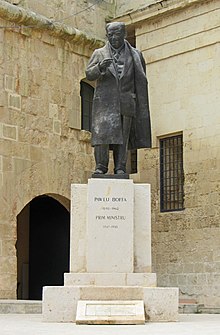Paul Boffa
| Paul (Pawlu) Boffa | |
|---|---|
 |
|
| 5th Prime Minister of Malta | |
|
In office 4 November 1947 – 26 September 1950 |
|
| Monarch | George VI |
| Governor-General |
Francis Douglas Gerald Creasy |
| Preceded by | Position Abolished |
| Succeeded by | Enrico Mizzi |
| Personal details | |
| Born | 30 June 1890 Birgu, Malta |
| Died | 6 July 1962 Paola, Malta |
| Political party | Labour Party |
| Spouse(s) | Genoveffa Cecy |
| Children | 4 |
| Religion | Roman Catholic |
Sir Paul Boffa, OBE (30 June 1890 – 6 July 1962) was a Maltese prime minister (1947–50) who took office after self-rule was reinstated by the British colonial authority following the end of World War II.
Born in Vittoriosa on 30 June 1890, Paul Boffa was educated at the Lyceum and at the University of Malta from where he graduated as a medical doctor in 1912. During World War I, he served with the Royal Medical Corps in Malta, Salonika and on hospital ships. After the war he set up in private practice in Paola. In 1921, he married Genoveffa Cecy and had two sons and two daughters: Salvino (aka Vivi), Hilda, Joseph (aka Profs), Carmelina (aka Melina). He died at his residence in Paola and is buried at the All Souls Cemetery in Tarxien. Former King George V (KGV) Hospital - a memorial to the men of the Merchant Navy who died in World War 1 - was renamed to Sir Paul Boffa Hospital in 1976.
Paul Boffa entered politics when Malta was granted self-government in 1921 and joined the Labour Party in 1923. He was returned to Legislative Assembly under the Amery-Milner Constitution in 1924, 1927 and 1932 and elected Leader of the Labour Party in 1927. The Labour and the Constitutional Parties formed an electoral agreement (known as the "Compact") for the 1927 elections. Thanks to this the Constitutional Party was able to form a government with the support of Labour although this was not a coalition in the true sense of the word as Labour refused to assume any ministerial portfolios. In 1932 Boffa was the only Labour Party candidate elected to the Legislative Assembly until it was dissolved in 1933. He was nominated as a member of the Executive Council from 1936 to 1939 and was elected, again as the sole Labour representative, to the Council of Government in 1939.
...
Wikipedia
